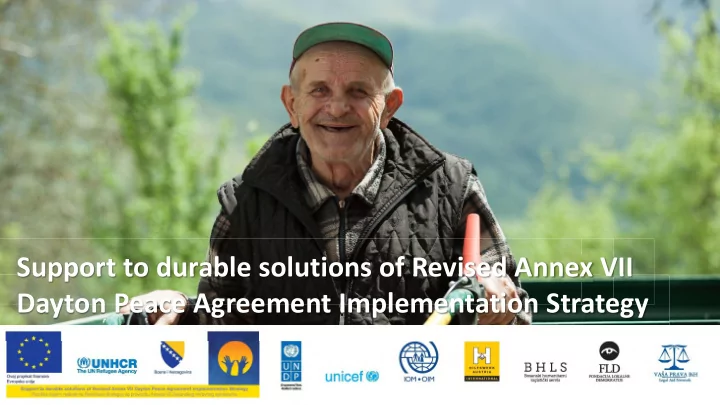

Support to durable solutions of Revised Annex VII Dayton Peace Agreement Implementation Strategy
Context Internally Displaced People (IDPs) • some 98,000 IDPs in Bosnia and Herzegovina, of whom: some 16,200 IDPs (5,620 households) in Brčko District BiH and nine project cities/municipalities. Returnees • UNHCR estimates that there are currently about 47,000 vulnerable minority* returnees living in settlements, of which some 50% face Annex VII-related problems. *"Minority" return is a technical term that refers to a person (constituent peoples) who have returned to their pre-war municipalities of residence where currently other constituent peoples prevail in terms of numbers.
The Project Background In 2013, a UNHCR and UZOPI survey re-confirmed that a significant number of displaced people still live in unacceptable conditions. In 2014, BiH authorities and international partners launched the Project to develop a collaborative multi- sectoral approach to implementation of the Annex VII Revised Strategy. The Project has a total value of EUR 8,1 million of which EUR 7 million is allocated by the EU under the IPA 2012 programme while rest is co-financed by UNHCR. The Project was implemented in Brčko District BiH and nine cities/municipalites ( Bijeljina, Bosanski Petrovac, Derventa, Foča, Gradiška, Maglaj, Mostar, Prijedor and Živinice )
Overall Objective To enable national actors to address the remaining obstacles to solutions for displaced persons and returnees in accordance with the Revised Annex VII DPA Implementation Strategy goals. Specific Objectives To provide durable housing solutions to vulnerable returnee and IDP families To provide sustainable economic opportunities to returnee and IDP families To enable vulnerable returnees and IDPs to access their rights and inclusive social services
The Methodology A major feature of the Project was the introduction of a four-step methodology : Multifaceted approach Needs-based prioritization of beneficiaries Teamwork approach Standard Operating Procedures
Step 1 - Multifaceted approach Labour and Social Housing Education Health Care Protection Livelihoods FREE LEGAL AID Safety and Damage Property Electrification Infrastructure De-mining Compensation Reposession (public utilities)
Step 2 - Needs-based prioritization of beneficiaries Gradiška Derventa Prijedor Brčko District BiH Bijeljina UNHCR/UZOPI survey highlighted neediest areas Bosanski Petrovac Selecting locations with MHRR and Project Maglaj partners Živinice Further selection at field level in teamwork between UNHCR, authorities, project partners and other civil society Mostar Foča 1 st Priority Municipalities 2 nd Priority Municipalities
Step 2 - Needs-based prioritization of beneficiaries Eligibility based on STATUS Prioritization based on NEEDS Prioritization based on NEEDS Prioritization based on NEEDS Prioritization based on NEEDS Prioritization based on NEEDS (vulnerability, intention and (vulnerability, intention and (vulnerability, intention and capacity) ASSISTANCE TO ASSISTANCE TO ASSISTANCE TO HOUSING ELDERLY EDUCATION VALUE CHAINS Multiple assistance LEGAL AID LIVELIHOOD Is possible Is Is Is Is Is DURABLE SOLUTION
Step 3 – Teamwork approach CITY/MUNICIPALITY COMMISSION FOR SOCIAL New Annex VII structure! PROTECTION AND INCLUSION (municipal staff, partners, health and education sectors, police, civil society) CITY/MUNICIPALITY OPERATIONAL TEAM Multifunctional team! all members of Working Groups WORKING WORKING GROUP FOR WORKING GROUP FOR SOCIAL GROUP FOR ECONOMIC PROTECTION HOUSING Teams working in the field! SUSTAINABILITY AND INCLUSION (municipal staff, (municipal staff, (municipal staff, partners, civil partners, civil society, partners, health and society, UNHCR) UNHCR) education sectors, police, civil society)
Step 3 – Team Work
Step 4 – Standard Operating Procedures Standard Operating Procedures: Assess Plan Coordinate
Establishment of Commissions for social protection and inclusion adoption of SPI Action plans at city/municipality level 20 10 10 15 ESTABLISHMENT OF SPI ESTABLISHMENT OF SPI 10 10 10 COMMISIONS AND ADOPTION 5 0 OF ACTION PLANS Planned Achieved SPI
Provision of basic and specific services for vulnerable children and families 600 500 400 600 300 200 300 100 INCLUSIVE SERVICES FOR INCLUSIVE SERVICES FOR INCLUSIVE SERVICES FOR INCLUSIVE SERVICES FOR 0 Planned Achieved Number of children CHILDREN AND FAMILIES
Number of people that received free legal 700 600 500 400 631 300 500 200 100 0 Planned Achieved FREE LEGAL AID Further 9,439 legal assistances were provided in the rest of BiH
Number of elderly displaced people receiving psycho-social assistance 300 250 111 200 150 165 100 150 INCLUSIVE SOCIAL INCLUSIVE SOCIAL 50 0 Planned Achieved SERVICES Psycho-social assistance at home FOR ELDERLY Psycho-social assistance provided during workshops
Income-generation grants for vulnerable displaced people LIVELIHOOD HWA FLD 800 SUPPORT 211 700 600 155 500 157 400 Specific Vocational Psycho-social Small and medium Displaced 132 300 activities training delivered support provided enterprises supported people 396 200 employed 231 100 Planned 48 0 10 N/A 0 Achieved 73 56 10 18 Planned Achieved Total achieved: 762 Total Planned : 520
Value Chains Locations Households Established supported 5 7 223 + 19 that disengaged Beneficiaries trained, supported and included in Value Chains 250 19 200 150 223 100 SUPPORT THROUGH SUPPORT THROUGH 100 50 0 VALUE CHAINS Planned Achieved Achieved but disengaged
Total Planned Total Achieved 125 179 Number of (re)constructed housing units and connection to utilities for HWA vulnerable displaced people (RE)CONSTRUCTION 200 22 OF HOUSING 150 20 100 UNITS AND CONNECTION UNITS AND CONNECTION 157 105 50 TO UTILITIES 0 Planned Achieved
Summary Nine cities/municipalities and BD are now aware of needs of displaced population They have a structure and methodology to address those needs. They are equipped to continue applying the methodology. Needs-based, collaborative, multifaceted teamwork approach works well for Annex VII This ‘IPA Annex VII methodology’ could now be extended to other Annex VII projects However… This 3-year project is ending, and continuity and sustainability are not yet assured. More municipalities and needy families have still to be reached Authorities at all levels should apply this methodology to use of their own resources The establishment of the Ministerial Coordination Team is a step in that direction.
Thank you!
Recommend
More recommend